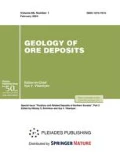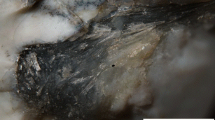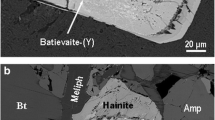Abstract
Calcioolivine has been included into the MDI mineral database in the list of grandfathered minerals. Its history, together with related artificial compounds, is extremely complex: various minerals and compounds received this name, including natural orthorhombic Ca orthosilicate. In this paper, the crystal structure and properties of natural calcioolivine are described for the first time. The new mineral has been found at Mt. Lakargi, Upper Chegem Plateau, the northern Caucasus, Kabarda-Balkaria Republic, Russia. It has been identified in skarnified, primary carbonate xenoliths entrained by middle to late Pliocene silicic ignimbrites of the Upper Chegem caldera. These xenoliths of a few centimeters to a few meters in size are located close to the volcanic vent. Calcioolivine rims relics of larnite and occurs as relict grains among crystals of spurrite, rondorfite, wadalite or secondary hillebrandite, afwillite, thaumasite, and ettringite. Hillebrandite is the major product of alteration of calcioolivine; larnite is relatively more resistant to low-temperature alteration. Spurrite, larnite, tilleyite, kilchoanite, cuspidine, wadalite, rondorfite, reinhardbraunsite, lakargiite (CaZrO3), members of ellestadite series, afwillite, ettringite, katoite, and thaumasite are associated minerals. It is inferred that calcioolivine has been produced as a result of interaction of host carbonate rocks in xenoliths with volcanic lava and gases during eruption. The name calcioolivine was approved by the Commission on New Minerals and Mineral Names, International Mineralogical Association, September 6, 2007 (no. 07-B).
Similar content being viewed by others
Refrences
A. M. Borsuk, Mesozoic and Cenozoic Igneous Associations of the Greater Caucasus (Nauka, Moscow, 1979) [in Russian].
N. L. Bowen, Am. J. Sci. Ser. 5, 3, 30 (1922).
T. E. Bridge, “Bredigite, Larnite and γ-Dicalcium Silicates from Marble Canyon,” Am. Miner. 51, 1768–1774 (1966).
B. V. Chesnokov, L. F. Bazhenova, A. F. Bushmakin, V. A Vilisov, Yu. L. Kretser, and T. P. Nishanbaev, “New Minerals from Burnt Waste Dumps of the Chelyabinsk Coal Basin (4th Communication),” in Ural Mineral Collection (UIF Nauka, Yekaterinburg, 1993), pp. 3–25 [in Russian].
A. M. Clark, Hey’s Mineral Index (Chapman & Hall, London, 1993).
Y.-S. Dai and J. E. Post, “Crystal Structure of Hillebrandite: A Natural Analog of Calcium Silicate Hydrate (CSH) Phases in Portland Cement,” Am. Miner. 80, 841–844 (1995).
A. l. Day, E. S. Shepherd, and F. E. Wright, “Lime Silica Series of Minerals,” Am. J. Sci. 22, 265–302 (1995).
W. A. Deer, R. A. Howie, and J. Zussman, Rock-Forming Minerals (Longmans, London, 1962), Vol. 1.
V. M. Gazeev, A. E. Zadov, A. E. Gurbanov, N. N. Pertsev, A. V. Mokhov, and A. Ya. Dokuchaev, “Rare Minerals From the Upper Chegem Caldera (in Xenolites of Skarnified Limestone from Ignimbrites),” in Bull. Vladikavkaz. Sci. Centre (Gassiev IPP, Vladikavkaz, 2006), Vol. 6, No. 1, pp. 18–27.
E. N. Gramenitsky, A. R. Kotel’nikov, A. M. Batanova, T. I. Shchekina, and P. Yu. Plechev, Experimental and Technical Petrology (Nauchnyi Mir, Moscow, 2000) [in Russian].
G. Hentschel, Die Mineralien der Eifelvulkane, Zweite Auflage (Weise Verlag, Muenchen, 1987), pp. 22–29.
Handbuch der Mineralogie, Erganzungsbd, Ed. by G. Linck (Berlin, 1938).
P. W. Lipman, O. A. Bogatikov, A. A. Tsvetkov, C. Gazis, A. G. Gurbanov, K. Hon, N. V. Koronovsky, et al., “2.8 Ma Ash-Flow Caldera at Chegem River in the Northern Caucasus Mountain (Russia), Cotemporaneous Granites and Associated Ore Deposits,” J. Volcanol. Geotherm. Res., 57, 85–124 (1993).
E. E. Milanovsky and N. V. Koronovsky, Orogenic Volcanism and Tectonics of the Alpine Belt of Eurasia (Nedra, Moscow, 1973) [in Russian].
T. Mihajlović, C. L. Lengauer, T. Ntaflos, et al., “Two New Minerals, Rondorfite, Ca8Mg[SiO4]4Cl2, and Al-Marudite, K(Na)2(Mn,Fe,Mg)2(Be,Al)3[Si12O30], and a Study of Iron-Rich Wadalite, Ca12[Al8Si4Fe2)O32]Cl6, from the Belleberger (Bellberg) Volcano, Eifel, Germany,” N. Jb. Miner. Abh. 179(3), 265–269 (2004).
W. G. Mumme, R. J. Hill, G. W. Bushnell, and E. R. Segnit, “Rietveld Crystal Structure Refinements, Crystal Chemistry and Calculated Powder Diffraction Data for the Polymorphs of Dicalcium Silicate and Related Phase,” N. Jb. Miner. Abh. 169(1), 35–68 (1995).
H. O’Daniel, L. Tscheischwili, and S. von Zur, “Structure γ-Ca2SiO4 and Na2BeF4,” Zeitschrift Kristallogr. 104, 124–141 (1942).
K. Oëbbeke, Ein Beitrag zur Kenntniss des Palaeopikrits und seiner Umwandlungsprodukte. Inaugural Dissertation, Wurzburg (Neues Jahrb. Miner., 1877).
F. P. Paul, Tschermaks Mineralogische und Petrographische Mitteilungen (1906), Vol. 25.
H. Strunz, Mineralogichen Tabellen (Leipzig, 1959).
H. Strunz and E. Nickel, Strunz Mineralogical Tables: Chemical-Structural Mineral Classification System, 9th Ed. (2001).
H. F. W. Taylor, Cement Chemistry (Academic Press, London, 1990; Mir, Moscow, 1996) [in Russian].
C. E. Tilley, “An Unnamed Mineral of the Olivine Group,” Geol. Mag. 64, 143–144 (1927).
C. E. Tilley, “A Monticellite-Nepheline Basalt from Tasmania: A Correction to Structure Data,” Geol. Mag. 65, 29–30 (1928).
C. E. Tilley, “On Larnite (Calcium Orthosilicate, a New Mineral) and Associated Minerals from the Limestone-Contact Zone of Scowt Hill, Co. Antrum,” Miner. Mag. 22(125), 76–86 (1929).
C. E. Tilley and H. C. G. Vincent, “The Occurrence of an Orthorhombic High-Temperature Form of Ca2SiO4 Bredigite in the Scowt Hill Contact-Zone and As a Constituent of Slags,” Miner. Mag., No. 200, 255–271 (1948).
A. N. Winchell and H. Winchell, Elements of Optical Mineralogy and Introduction to Microscopic Petrography (New York, 1951).
A. N. Winchell and H. Winchell, The Microscopically Characters of Artificial Inorganic Solid Substances: Optical Properties of Artificial Minerals (Acad. Press, New York, 1964).
N. H. Winchell and A. N. Winchell, Elements of Optical Mineralogy: An Introduction to Microscopic Petrography: Part II. Descriptions of Minerals (New York, 1927).
Author information
Authors and Affiliations
Corresponding author
Additional information
Original Russian Text © A.E. Zadov, V.M. Gazeev, N.N. Pertsev, E.R. Gobechiya, N.A. Yamnova, N.V. Chukanov, 2009, published in Zapiski RMO (Proceedings of the Russian Mineralogical Society), 2009, Pt. CXXXVII, No. 6, pp. 46–57.
Considered by the Commission on New Minerals and Mineral Names, Russian Mineralogical Society, January 17, 2007. Approved by the Commission on New Minerals and Mineral Names, International Mineralogical Association, September 6, 2007.
Rights and permissions
About this article
Cite this article
Zadov, A.E., Gazeev, V.M., Pertsev, N.N. et al. Calcioolivine, γ-Ca2SiO4, an old and New Mineral species. Geol. Ore Deposits 51, 741–749 (2009). https://doi.org/10.1134/S1075701509080066
Received:
Published:
Issue Date:
DOI: https://doi.org/10.1134/S1075701509080066




